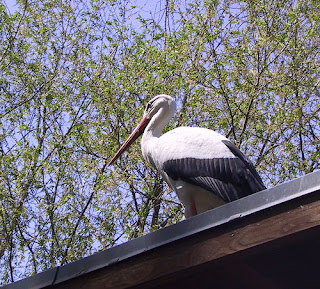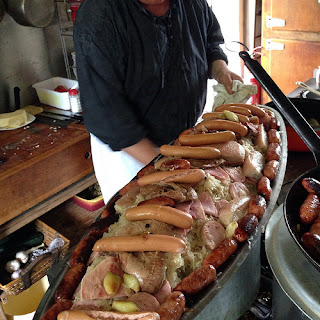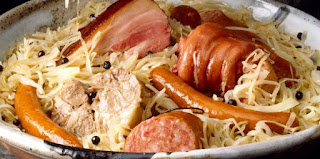from
Behind the French Menu
by
Bryan G. Newman
Gewurztraminer
I was introduced to the Gewurztraminer
AOP, a white wine from the Alsace some 40 (plus) years ago. Then, at a dinner
in the Alsatian town of Mulhouse, my hosts served a semi-dry, incredibly floral
wine. The wine had me spellbound. At that time, few visitors France had heard
of Gewurztraminer, including yours truly, and practically no one would see a
Gewurztraminer on a wine list unless they were here in the Alsace region in north-eastern
France. Gewurztraminer, called Gewürzt, by the locals, is a white wine that is
very different, full of flavor, and scented like no other.
Gewurztraminer grapes.
www.flickr.com/photos/25005304@N04/2372316220/
Unlike most other French AOP wines, the
AOP (AOC) wines of Alsace are allowed to be named after the grape variety from
which they are produced. Today Gewurztraminer wines are produced in just about
every wine-producing country in the world. However, the best of the Alsatian
Gewurztraminer AOP wines beat the best of the best from anywhere else. For some
clarity on these AOP and AOC labels, see my post: AOC and AOP on France's Foods and Wine
labels?
Mulhouse
France and Basel Switzerland.
The town of Mulhouse in the Alsace,
France, where I was introduced to Gewurztraminer, is close to the Swiss city of
Basel that holds many important exhibitions. The two towns are interlocked and
even share the same airport.
I spent ten or more days every year, for
over twenty-five years, at exhibitions in Basel. The evening were filled with endless
opportunities to enjoy excellent French cuisine and wonderful French wines,
including my favorite Alsatian white wine: Gewurztraminer.
The oldest wine barrel in the world.
Ste Caterine cask dated 1715 at Hugel Winery, Alsace, France.
Still in use according to the Guinness book of records
Before or after an exhibition, I would
join friends and explore the Alsace Route des Vins, the Alsace wine road. The
wine road begins close to Mulhouse which is thirty minutes from Basel and
continues on for another 115 km ( 72 miles) past Colmar and onto the region's
capital of Strasbourg. (Strasburg is also home to the European Union's
parliament and Colmar, less than an hour's ride from Basel is the Alsace’s
second-largest city. Colmar and to the
left and the right are tens, maybe hundreds, of excellent French restaurants,
large and small. While there are many outstanding restaurants in Basel itself,
France is always beckoning, and the wines are from France).
The City of Colmar
In the Alsace region of France.
(On 1-1-2016 the Alsace became part of the new super
region of the Grand Est).
www.flickr.com/photos/flavouz/11908478103/
Choosing a Gewurztraminer
AOP wine.
When choosing a Gewurztraminer AOP or
another regular Alsatian white wine (not a Grand Cru or Vendange Tardive wine),
do not buy wines more than three years old. Trust me; most Alsatian
three-year-old AOP white wines will be no better than a two-year-old wine. Four
or five-year-old white Alsatian wines are best when left in the wine shop
unless you have an expert to advise you. Ordinary Gewurztraminer wines are excellent
wines with only a few meant to be kept for years; drink them young.
Gewurztraminer Grand
Cru
Grand Crus are different, and so when
Grand Cru is on the bottle of an Alsatian wine, it indicates a separate
appellation, a distinct and unique growing area. The vineyards with the right
to produce Grand Cru wines are the home of the best of Alsatian wines. In 1975,
the right to add Grand Cru on an Alsatian wine’s label was legalized after
tests (a rarety for French wines),that included taste tests. Other vineyards
that applied later are tested, tasted, and some are added. When you buy a Grand
Cru wine, then the name of the vineyard must be on the label, and you need an
updated wine guide to choose among the many vintners and different years. N.B.
If you find a surprisingly cheap ten-year-old wine in a supermarket or wine
shop leave it; if it was any good the real experts would have bought all there
was long before you got there.
Gewurztraminer Grand Cru Zotzenberg.
Organic
I leave the Gewurztraminer Grand Cru wines at dinner to
the real mavens who can afford them, and enjoyed them when I was invited. Though the Grand Crus do include the very
very best, I do find excellent Gewurztraminer AOP wines without Grand Cru on
the label, and when the bill comes, they are easier to digest.
Gewurztraminer Vendange Tardive
(VT) wines
Vendange Tardive wines are made with grapes that are
left on the vine long past the usual harvest date; then, as the grapes begin to
dry out, the sugars and flavors are concentrated, resulting in the perfect
grape for a sweet dessert wine. Open a bottle of a Gewurztraminer Vendange
Tardive, and the area around is filled with the scent of flowers. These wines
may be offered as an aperitif or as a single glass accompanying certain dishes.
Gewürztraminer Sélection de
Grains Nobles (SGN)
Sélection de Grains Noble (SGN) Alsatian wines are
even sweeter than the vendange tardive wines and are considered the highest
grade of the Alsatian dessert wines. These wines are made when the grapes, on
the vine, have been infected by a helpful fungus called botrytis cinerea
(mostly known in English as the “noble rot”). As long as the climate is not
damp, this fungus does its magic and concentrates the sugars and scent a few
steps higher than the vendange tardive wines. The famous sweet Sauterne wines
of Bordeaux are also produced with the aid of the “noble rot.” When you buy any
of these fabulous SGN Alsatian dessert wines, remember this is a wine for
sipping and smelling, not for quaffing.
Marc de Gewurztraminer
Marcs, like Italian Grappas and similar brandies from
other wine-producing countries, are made from grape skins, leaves, pulp, and
seeds that are leftover from the production of wines. Initially, these
leftovers were processed into very rough brandies that were given freely to the
workers in the vineyards; they got drunk, and that took their minds off their
poverty. These cheap marcs and grappas were then slightly improved and
subsequently sold, cheaply, to the townspeople who could also get drunk cheaply
and forget their problems. Over the years, the methods of distillation
developed, and a second distillation produced a brandy that was smoother,
tastier, and more fragrant that could be sold to more discerning customers.
Today the better French Marcs and Italian Grappas,
with a 40 % alcohol content, are offered like other fine brandies in the finest
restaurants. A pleasant Marc’s scent will tell you the type of grape that was
used, and In the Alsace, your digestif should be a Marc de Gewurztraminer.
Gewurztraminer vinegar
adds its unique scent and taste to sauces. Vinaigrette and other sauces made
with vinegar bring that scent of flowers.
Vendanges Tardive Grand Cru Zinnkoepfle
Leon Boesch Gewurztraminer
Menus in the Alsace may Include:
Un Verre de Gewurztraminer Vendanges Tardives - A glass of sweet Gewurztraminer late harvest wine.
One of the best ways to enjoy this wine without buying the whole bottle.
White and green asparagus
Along with other goodies in the market.
www.flickr.com/photos/juniper_trees/3035879144/
N.B. On French menus "Maison"
while also indicating a home or implying "homemade" does not infer
that the competition is buying their product in the local supermarket! On a French menu, "Maison" indicates
a particular restaurant's or chef's take on a well-known dish.
Dos de Maigre aux
Effluves d'Epices Cuit sous Vos Yeux Sauce
Beurre Blanc au Gewurztraminer et son Risotto aux Champignons - A thick cut of meagre the
fish, also called croaker, scented with spices; all cooked in front of the
diner in a Beurre
Blanc sauce made with Gewurztraminer wine and accompanied by a button mushroom risotto. (Be careful using the word
"maigre" as it also means lean).
Escalope de Saumon Frais,
Sauce Légère au Gewurztraminer – Fresh salmon served with a light Gewurztraminer
flavored sauce.
Le Sorbet Citron Arrosé au Marc de Gewurztraminer – A lemon sorbet lightly flavored with a
Marc de Gewurztraminer; this may be offered between the main course and the dessert
menu:
Granité au
Melon Rose et Gewurztraminer AOC Alsace Grand Cru - A granite made with crushed frozen melon and rose
water, flavored with a Gewurztraminer Grand Cru. Granités were
originally the French take on Italian granitas, and in the beginning, they were
sugar, fruiKougelhopf cake, and water served with crushed ice, a
sludge. Many guide books still translate a French granité as sludge
in English. However, the granités served in most French restaurants
have moved on and are now very different from a sludge.
Kougelhopf Glacé au Marc de Gewurztraminer, Coulis aux Fruits Rouge - This is a popular Alsatian dessert where an ice-cream cake is often
made using the traditional engraved Kougelhopf cake
pan. You will receive a slice of this ice-cream cake shaped like a
regular Kougelhopf cake. In this menu listing the ice cream is
flavored with a Marc de Gewurztraminer and accompanied by a puree of berries,
strawberries and other red fruits.
Un
Verre de Gewurztraminer Vendanges Tardives - A glass of sweet Gewurztraminer late harvest wine.
One of the best ways to enjoy this wine without buying the whole bottle.
At the end of a meal, Alsatian menus may offer an
Alsatian coffee:
Café Alsacien –
An Alsatian coffee; a shot of black espresso coffee served with whipped cream
and a shot of Gewurztraminer Marc. (A similar coffee elsewhere in France,
without the whipped cream, will be a Café
Cognac).
Kougelhopf (Gugelhupf) with Alsatian Coffee by the side.
Photograph Courtesy of Lyons Coffee
The Kougelhopf cake, also called Gugelhupf, Kouglof,
and other similar names, include cakes that today have a wide variety of
recipes. The original Kougelhopf was a raisin-filled yeast bread made in
traditional engraved pans with a hole in the middle; these pans with their
engravings have become collectors’ items. As a child, I remember my Oma, my
Austrian Grandmother making these cakes on the stovetop.
Kougelhopf pans
Betschdorf and Soufflenheim for Alsatian pottery
Exploring the Alsace
With friends and family who joined us after the
annual Basel exhibition, we would explore the Route des Vins d’Alsace. This
Alsace wine road extends from the South, near the small town of Thann, 25
minutes from Mulhouse to the North of the Alsace, just past Marlenheim, 24
minutes from Strasbourg for over 120 km (75 miles); however, that is as the
crow flies, but double that distance if you follow the route on the map. There
are close to 100 towns and villages along the way, all with wine and tourism an
important part of their economies. We quickly learned the way to enjoy a
weekend in the Alsatian wine country with the wine road as our guide was to
take a single 5 km to maybe 10 km (3 to 6 mile) section.
The village of Eguisheim,
(Forty minutes from Basel and fifteen minutes from Colmar).
Photograph courtesy of Tambako The Jaguar.
www.flickr.com/photos/tambako/6083024453/
We would wander around beautiful small
towns and villages. There we could join in the wine tastings that sometimes
seem to be set up every 20 meters and enjoy the beautiful houses, many with
nesting storks on their roofs. For lunch, we would have a
traditional Alsatian tarte flambé and then wander or drive around the
beautiful countryside while discussing dinner.
A stork sitting on a house in Hunawihr, Alsace
(Thirty minutes from Colmar and one hour from Basel).
www.flickr.com/photos/unnormalized/7832026576/
The Gewurztraminer fete.
If you are in the Alsace at the end of July, then on
the last Saturday and Sunday, there is a Fête du Gewurztraminer, a
Gewurztraminer fete, in and around the communes of Ribeauvillé and Riquewihr.
Ribeauvillé and Riquewihr, the small town and the village, are about 20
minutes' drive north of Colmar. You will find more information about their
communes and their wine fete's exact dates on their English language website
at:
http://www.ribeauville-riquewihr.com/en/
--------------------------------
Behind the French Menu
by
Bryan G. Newman
Copyright 2010, 2013, 2014, 2019
--------------------------------
Searching for the meaning of words, names or phrases
on
French menus?
Just add the word, words, or phrase that
you are searching for to the words "Behind the French Menu" (best
when including the inverted commas), and search with Google, Bing, or another
browser. Behind the French Menu’s links, include hundreds of words,
names, and phrases that are seen on French menus. There are over 450 articles
that include over 4,000 French dishes with English translations and
explanations.
Connected posts:



















